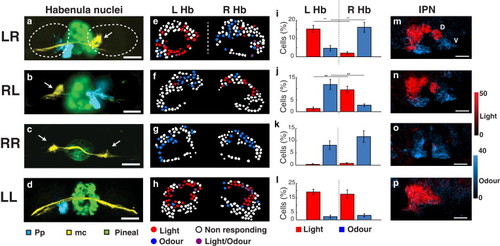Fig. 3
- ID
- ZDB-FIG-140512-46
- Publication
- Dreosti et al., 2014 - Left-right asymmetry is required for the habenulae to respond to both visual and olfactory stimuli
- Other Figures
- All Figure Page
- Back to All Figure Page
|
Developmental Disruption of dHb Asymmetry Leads to Loss of Sensory Responses to Light or Odor (A–D) Confocal images of the epithalamus of wild-type (A), cold-shocked (B), parapineal-ablated (C), and IWR1-treated (D) Tg(foxD3:GFP × lhx2a:Gap43-YFP) 4 dpf fish showing normally lateralized (LR), reversed (RL), double-right (RR), and double-left (LL) epithalami. Olfactory mitral cell projections (white arrows) terminate in the right dHb nucleus in the wild-type brain (A), terminate in the left dHb in the reversed brain (B), are bilateral in the double-right brain (C), and are reduced/absent in the double-left brain (D). Parapineal neuron projections (pseudocolored cyan) terminate in the left dHb in the wild-type and double-left brain (A and D), terminate in the right dHb in the reversed brain (B), and are reduced/absent in the double-right brain (C). (E–H) Examples of single z planes of the dHb (as in Figures 1B and 2A) of wild-type (E), cold-shocked (F), parapineal-ablated (G), and IWR1-treated (H) Tg(foxD3:GFP × lhx2a:Gap43-YFP) 4 dpf fish as in (A)–(D) showing lateralization of neuronal responses to light and odor. Neuronal cell bodies are shown as ROIs color coded in red, blue, violet, or white depending on whether they responded to light, responded to odor, responded to both light and odor, or were nonresponding. Only neurons with amplitude responses greater than 2 SDs from the prestimulus baseline are considered as responding. Neurons that showed an inhibitory response are not shown. (I–L) Bar charts showing the percentages of light (red)- versus odor (blue)-responding neurons (normalized to the total number of dHb neurons) in the left and right dHb nuclei for two sampled planes (at depths of 7 and 14 µm) in multiple fish of each of the classes shown in (A)–(D). For the wild-type (I), an average of about 17% of neurons respond to light 20% to odor and 1% to both (n = 8 fish). The LR difference in light responses was significant (p = 4 × 105), as was the LR difference in odor responses (p = 5 × 104; p < 0.001, Student’s t test). For reversed fish (J), about 10% of dHb neurons respond on average to light, 14% to odor, and 0.6% to both. LR difference responses was significant to light (p = 0.0056) and odor (p = 0.0072) (n = 7 fish). In double-right-brained fish (K), 21% of neurons were odor responding, with light-responding neurons reduced to 0.5% and those responding to both to 0.2% (n = 8 fish), whereas double-left-brained fish (L) showed an increased percentage of neurons responding to light (35%), a reduced number responding to odor (3%), and 3% responding to both (n = 6 fish). Error bars indicate the SEM. (M–P) Sagittal views of the IPN in Tg(elavl3:GCaMP5G) 4 dpf fish showing excitation in response to light (red) and odor (blue), color coded depending on their ΔF/F responses. In the wild-type (M) and reversed (N) fish, light and odor responses are localized in the dorsal and ventral IPN, respectively. In the IPN of the double-left-brained fish (P), virtually all IPN responses were upon light stimulation, whereas in the double-right-brained fish (O), virtually all IPN responses were upon odor stimulation. Scale bars, 20 μm. D, dorsal; V, ventral; Pp, parapineal; mc, mitral cell axons and terminals; LHb, left habenula nucleus; R Hb, right habenula nucleus. See also Figures S3 and S4. |

